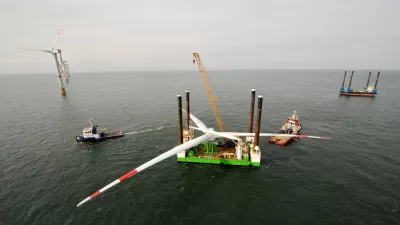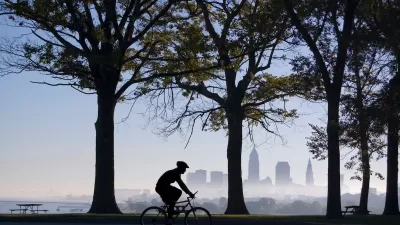A rainwater retention facility in Cleveland represents a small step forward with a controversial 25-year, $3 billion plan to clean Lake Erie.
"Officials on Monday unveiled the first of a series of ''green' projects that use natural landscaping, rather than underground pipes, to absorb rainwater and help reduce sewage overflows into Lake Erie," reports Andrew J. Tobias.
The so-called "Project Clean Lake" [pdf] would implement a federal consent decree requiring the Northeast Ohio Regional Sewer District to reduce the total volume of raw sewage discharges from 4.5 billion gallons to 494 million gallons annually. The sewer district's proposed plans to meet the requirements of the consent decree have provoked opposition from stakeholders and the media who prefer a "cheaper, greener" approach.
The recently revealed project makes use of three sites in the "foreclosure-blighted" Slavic Village neighborhood by installing "a man-made basin designed to collect and absorb rain water that otherwise would flow into sewers," according to Tobias.
"Northeast Ohio Regional Sewer District officials envision the projects as a component of their $3 billion effort to dig giant underground storage tunnels to keep storm runoff from flooding sewers and sending untreated sewage into Lake Erie." This component of the plan cost $338,000, but another 10 projects are already planned, with a pricetag of $82 million.
FULL STORY: First 'green' sites unveiled in $3 billion effort to keep sewage out of Lake Erie

Manufactured Crisis: Losing the Nation’s Largest Source of Unsubsidized Affordable Housing
Manufactured housing communities have long been an affordable housing option for millions of people living in the U.S., but that affordability is disappearing rapidly. How did we get here?

Americans May Be Stuck — But Why?
Americans are moving a lot less than they once did, and that is a problem. While Yoni Applebaum, in his highly-publicized article Stuck, gets the reasons badly wrong, it's still important to ask: why are we moving so much less than before?

Using Old Oil and Gas Wells for Green Energy Storage
Penn State researchers have found that repurposing abandoned oil and gas wells for geothermal-assisted compressed-air energy storage can boost efficiency, reduce environmental risks, and support clean energy and job transitions.

Poorest NYC Neighborhoods Pay Price for Delivery Boom
The rise of ‘last-mile’ e-commerce warehouses — and their attendant truck traffic and air pollution — is disproportionately impacting the most historically disadvantaged parts of the city.

Greening Oakland’s School Grounds
With help from community partners like the Trust for Public Land, Oakland Unified School District is turning barren, asphalt-covered schoolyards into vibrant, green spaces that support outdoor learning, play, and student well-being.

California Governor Suspends CEQA Reviews for Utilities in Fire Areas
Utility restoration efforts in areas affected by the January wildfires in Los Angeles will be exempt from environmental regulations to speed up the rebuilding of essential infrastructure.
Urban Design for Planners 1: Software Tools
This six-course series explores essential urban design concepts using open source software and equips planners with the tools they need to participate fully in the urban design process.
Planning for Universal Design
Learn the tools for implementing Universal Design in planning regulations.
Heyer Gruel & Associates PA
City of Moreno Valley
Institute for Housing and Urban Development Studies (IHS)
City of Grandview
Harvard GSD Executive Education
Salt Lake City
NYU Wagner Graduate School of Public Service
City of Cambridge, Maryland





























